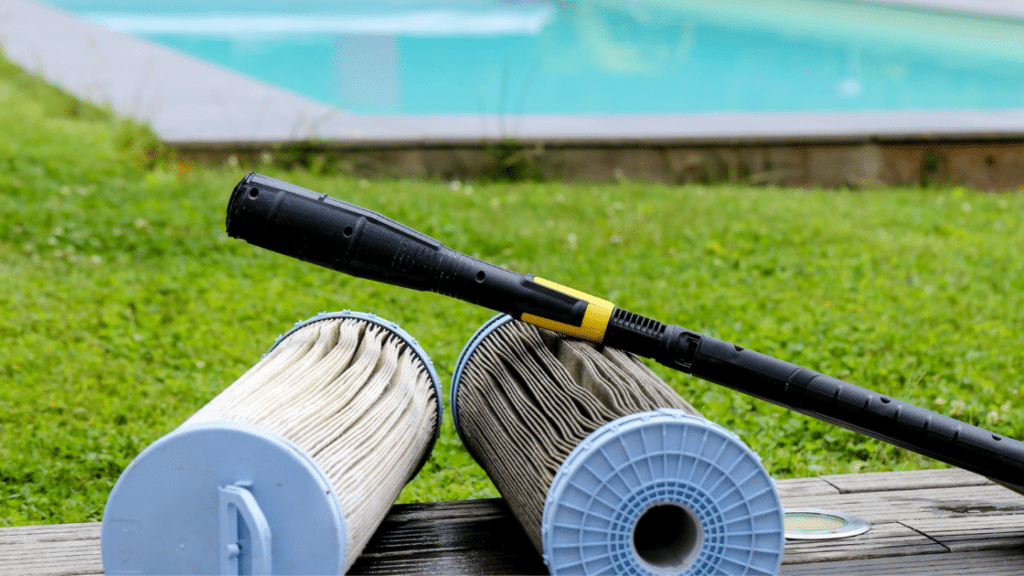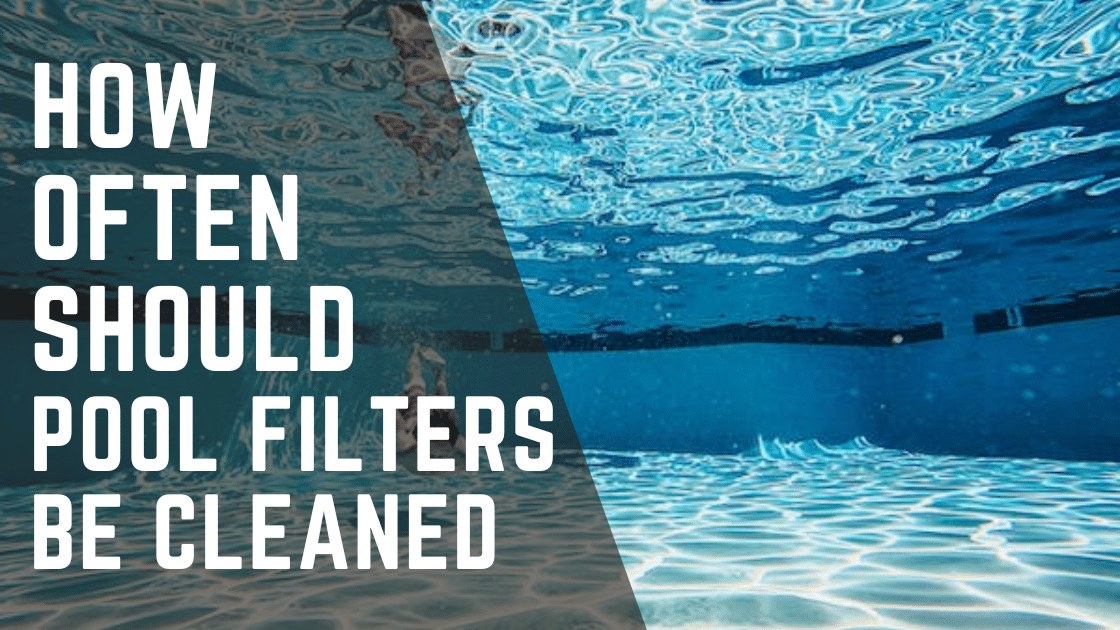Published by Ahmad Jamal on February 25, 2023 | Last updated on May 15, 2023
Dipping in your pool is the ultimate way to cool down in the summer, so it is important to ensure that your pool remains clean. In addition, you need a regular cleaning schedule for the pool filter to work efficiently, which is an important aspect of pool maintenance.
A dirty pool looks unsightly and can harbor bacteria and microorganisms, leading to severe infections. Here’s a complete guide to cleaning your pool filter.
In this CleanersAdvisor guide, we’ll discuss everything related to how often should pool filters be cleaned with a deep analysis on how they work, and how you should clean them.
- How Do Pool Filters Work?
- Types of Pool Filters
- Is Pool Filter Cleaning Necessary?
- How Often Should Pool Filters be Cleaned?
- How To Save Time and Keep Your Pool in Top Shape
- How Long Do Filter Cartridge Elements Last?
- A Stepwise Approach To How Often Should Pool Filters be Cleaned
- Additional Cleaning Tips
- Conclusion
How Do Pool Filters Work?
Filters are an essential part of the pool and help keep the pool free from dirt, insects, food particles, debris, and even bacteria. They play an essential role in keeping the pool clean and contamination-free.
Many filters serve different functions; depending on the pool size, budget, and equipment capacity, you can choose any.

Types of Pool Filters
Before we get into the cleaning details, you need to know the different filters usually used in pools. Generally, three types of filters are available: cartridge filters, D.E. filters, and sand filters. When any of the filters become clogged, two things happen.
- There is a rise in the filter pressure system.
- There is a drop in the overall flow rate of the swimming pool circulation system.
These issues can spiral into significant damage to the pool and the equipment if not cleaned properly. This is why it is essential to know how to clean your pool quickly and efficiently through tips and tricks on https://easypoolcleaning.com/.
Is Pool Filter Cleaning Necessary?
Frequent pool use over time will lead to the build-up of chemicals and debris, so the filter becomes clogged, resulting in cloudy water brimming with bacteria. A clogged filter can also damage the pool pump as the backflow can cause flooding and also cause the spread of infectious diseases.
Good maintenance of the filter reduces the extent of wear and tear, making your filter last longer. The filters are also essential to allow the chemicals added to the pool to circulate properly.
How Often Should Pool Filters be Cleaned?
The filter’s mechanism will greatly determine How Often Should Pool Filters be Cleaned. However, a general rule of thumb is that the higher the pressure, the more likely your pool needs to be cleaned. Let’s walk you through the cleaning cycles of the various filters.
- Cartridge Filters
Cartridge filters should ideally be cleaned every 6-8 weeks. However, even with regular cleaning, the filter’s efficiency can drastically drop if you consistently go over the flow limit of the filter.
This can be easily avoided by following the maximum pressure limit, which is usually written on the label on the outer layer of the filter. Also, bear in mind that a power washer must be avoided at all costs, given that it can significantly damage the filter material. Lastly, soak the filter in a cleaning solution to remove any residue or debris at the end of the cleaning process.
However, your filter won’t return to the pristine white color like when it was purchased, no matter how much you clean them. The discoloration is due to exposure to the chemicals in the pool water over a prolonged period.
- D.E. Filters
D.E. filters work by using diatomaceous earth to filter particles. Hence, they need to be cleaned using backwash quarterly or half yearly, depending on their usage. However, backwashing causes this filter material to be washed away along with the pool water residue and needs to be refilled after each cleaning session.
Furthermore, all pool owners must attempt at least one thorough cleaning every year, which involves dismantling the entire filter and cleaning all the parts individually.
- Sand Filters
These filters should be cleaned every 1-4 weeks or at a greater pressure than 5-10 PSI. These filters are efficient and low maintenance compared to the earlier filters. This, combined with the ability to refill the filters after three to five years, makes them popular.
How To Save Time and Keep Your Pool in Top Shape
If you need more time to clean your filter and pool or find the process rigorous and tiring, you can assign the responsibility to experts.
Many professionals can perform inspections, filter cleaning, and equipment repair, but it’s up to you to decide it their fees fit the bill.
How Long Do Filter Cartridge Elements Last?
Usually, you can use your cartridge filters comfortably for 2-3 years and even more in the case of oversized filters or if the pool water pressure is low.
On the other hand, an ill-fitted, small, overworked filter is unlikely to last longer than a year under high pressure.
A Stepwise Approach To How Often Should Pool Filters be Cleaned
Let’s walk through the process of cleaning the pool cartridge in a concise stepwise manner, as it can be confusing for a beginner.
Step 1: The first and most crucial step is to turn off the filter; otherwise, you risk a nasty shock from any scheduled programs that might be switched on while cleaning.
Step 2: Then release the air valve, which is located on the filter top, to release the pressure. This is followed by unplugging the filter from the bottom to empty its contents.
Step 3: To access the filter cartridge, you will need to remove the filter top by unscrewing the locking knob or with the help of a wrench. Then remove the bolt and C-clamp.
Depending on the cartridge type, a different socket may be required. For example, a Jandy cartridge needs a 9/16” socket, whereas a Hayward cartridge filter needs a ⅝” socket.
Step 4: After removing the top of the cartridge filter, remove the filter body. You will notice 1-4 filter cartridges depending on the filter size.
Step 5: Now place the cartridge filter in a cleaning space. Then use a full spray nozzle to clean the filter as thoroughly as possible. The best way is to clean by starting at the top and moving the debris to the bottom of the cartridge.
When cleaning, make sure to rotate the cartridge for thorough cleaning. Also, make sure to rinse the folds in the top and bottom of the cartridge.
Step 6: After cleaning the cartridges, place them on the filter support at the bottom. For most cartridges, the top manifold assembly must be installed for support. After installation, connect the manifold to the white outlet tube.
Step 7: Ensure the filter O-ring is properly set in the filter canister channel. Remove any debris around the O-ring for a proper seal or fit.
Step 8: Position the O-ring while re-installing the top of the filter.
Step 9: Now install the filter clamp and tighten the bolt. Tap the clamp with a mallet to ensure a snug fit when tightening the bolt.
Step 10: Use a ratchet and the appropriate socket size to tighten the locking bolt. But moving the bolt knob clockwise is enough to tighten it in most cases.
Step 11: You must re-pressurize the equipment pad by turning on the filter pump. Ensure the air relief valve is open to let the air leak out of the filter. Then close the air valve when the water sprays out of the valve, indicated by a hissing sound before the water sprays out.
Step 12: Finally, check the pressure gauge to ensure the filter pressure is at the recommended level between 8-15 PSI.
And congratulations, you have completed the difficult cleaning of your pool filter.
Additional Cleaning Tips
In addition to the cleaning steps, here are some quick tips for cleaning any filter.
- Avoid using a power washer, as the force can damage the filter materials. This will limit your shelf-life and cost more money in the future.
- You need not clean until the filter is white; it will still be functional, even if it looks dirty.
- Soak the filter in a pool cleaning solution from any local pool store at least once every year. This helps extend the life of the pool filter by removing tough buildup.
- Here’s a video that would help you out too:
Conclusion
Which is the best filter for your pool? You only need to find one that works best for your collection. If a clean filter fails, it needs to be looked at by a professional. A full-functional filter is essential for sparkling pool parties.
So whichever pool filter you choose, you must know how to use and clean it to continue functioning properly with a long shelf-life. Then, head into pool season with a clean, wonderful oasis to cool off during the summer, thanks to a healthy filter.
This guide to How Often Should Pool Filters be Cleaned by CleanersAdvisor has already provided you with enough feedback on how you should deal with filters, in addition to a helpful video, and a step-by-step guide on how to perform the operation.


![Criterion Dishwasher Reviews [According to 2023 Tests]](https://cleanersadvisor.com/wp-content/uploads/2023/03/Blog-Banner-for-Website-Content-41-350x190.png)
![Zline Dishwasher Reviews [According to 2023 Tests]](https://cleanersadvisor.com/wp-content/uploads/2023/03/Blog-Banner-for-Website-Content-42-350x190.png)

![GE Dishwasher Reviews [According to 2023 Tests]](https://cleanersadvisor.com/wp-content/uploads/2023/03/Blog-Banner-for-Website-Content-37-350x190.png)
![Miele Dishwasher Reviews [According to 2023 Tests]](https://cleanersadvisor.com/wp-content/uploads/2023/03/Blog-Banner-for-Website-Content-34-350x190.png)
![Cove Dishwasher Review [According to 2023 Tests]](https://cleanersadvisor.com/wp-content/uploads/2023/03/Blog-Banner-for-Website-Content-31-350x190.png)